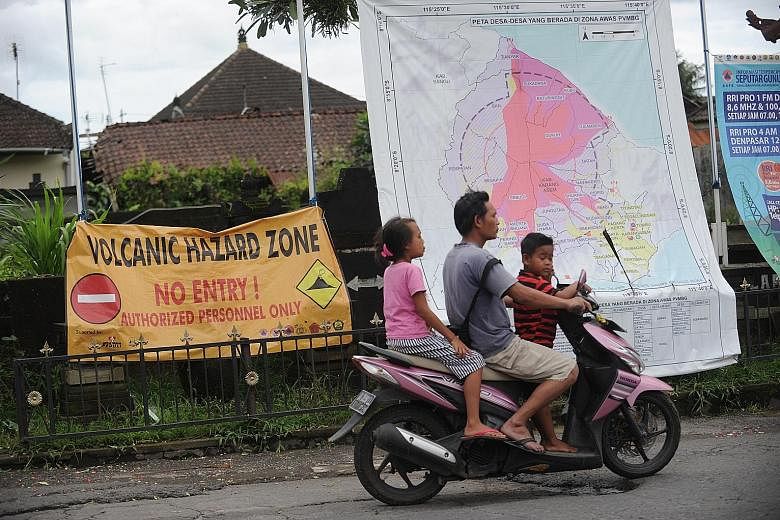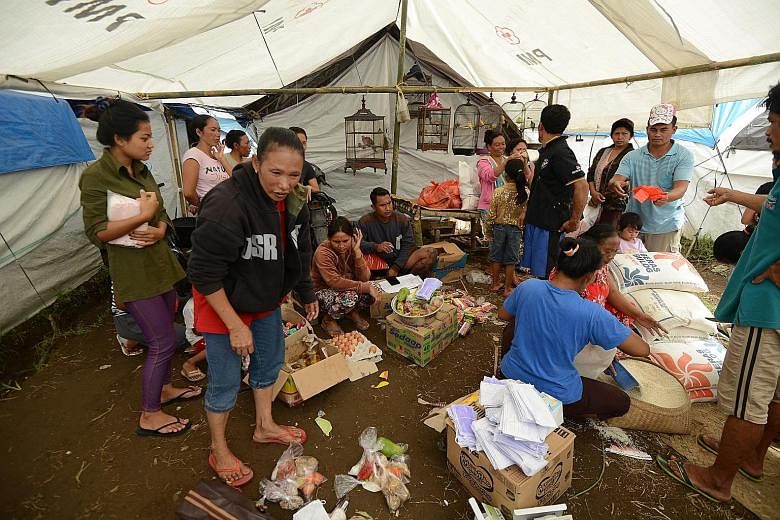KARANGASEM (Bali) • After lying dormant for 54 years, Mount Agung suddenly came to life in September, shooting ash, gravel and steam high into the sky, and rattling villages with tremors "sounding like jets".
The authorities raised the alert level to the highest "awas", Bahasa Indonesia for "warning", suggesting that a major eruption could be imminent.
More than 72,000 residents living within a radius of 10km from the volcano's crater, or danger zone, were evacuated to 240 emergency shelters, according to the latest figures from the National Disaster Management Agency.
Some 9,000 people from 10 villages have been housed in a sprawling complex of tents for the past four months, sharing everything from water and food such as instant noodles, vegetables and eggs, to medicine and communal toilets.
Supplies are plentiful, but they are worried that the long wait might affect their livelihood.
Most of them are farmers.
When The Sunday Times visited one of the shelters last week, some were milling around, while others were chatting with each other or browsing Facebook. Some were resting on king-size mattresses they had lugged from their homes.
Mr Nengah Kenek, 41, a temple cleaner, said his entire village in Besakih was covered in ash.
"All the trees, crops and grass have been killed by ash and acid rain," he said. "What do we eat without our crops?"
He said he was grateful to the government as well as local and international communities for their concern, and for providing them with essential supplies.
As "orang gunung" or mountain dwellers, he is prepared to face the aftermath of the eruption. But the question is, for how long?
"I'm most afraid that my children cannot go to school. I'm illiterate and I want them to have a proper education. Let's hope that this will pass soon," he said.
Logistics coordinator Wayan Sudiarta told The Sunday Times that some evacuees return to check on their homes and livestock in the villages during the day. "If there's no eruption, they will go home. Our data team will check every few days to make sure they return," he said.
"There are a few dozen who are stubborn and refuse to evacuate, no matter how hard we try to persuade them. But I'm sure they will leave when there's a major eruption."
Living in a tent is far from comfortable as it becomes hot on sunny days and humid and muddy on rainy days, the evacuees said.
For farmer Ketut Senin, 30, waiting in line to use the few toilets available is a pain.
"The worst is when someone has diarrhoea," she said with a laugh.
Her mother had been forced to sell more than a dozen cows, goats and chicken cheaply because some became ill and others suffered when volcanic debris rained on them, she said.
For now, anything is better than returning to her home on the volcano slope. "I won't be able to have peace of mind. I will surely panic if I hear any loud sound and wonder if the volcano is erupting," she said.
"I will stay here for as long as the government wants me to. Better to be safe than sorry." Arlina Arshad



